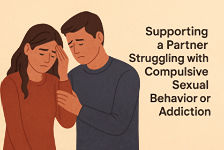Sex Addiction Blogs
Is “Looking” an Addiction?

When Looking Becomes Compulsive
In my work as a sex addiction counselor, I often see men who describe themselves as “overactive lookers.” There’s an important difference between simply noticing someone attractive and looking with compulsive energy:
- Noticing is a brief, passing awareness.
- Compulsive looking feels impossible to stop. It often comes with objectifying thoughts—reducing someone to body parts (“Look at that”)—and happens automatically, without conscious awareness.
Partners often notice this behavior and report feeling disrespected, compared, or even invisible. This is where looking can become part of an addictive cycle.
Why Looking Matters in Porn and Sex Addiction
Looking itself can act as a form of “pre-ritual” in porn addiction or sex addiction recovery. For example:
- A man addicted to pornography may scan women in public, then later search for porn that matches what he saw.
- Looking becomes a tool that fuels the cycle of obsession, objectification, and acting out.
Recognizing that looking is more than “just noticing” is the first step in breaking free from compulsive patterns. In porn addiction recovery, we work to raise awareness and provide tools to stop these behaviors before they escalate.
Practical Tools to Manage Compulsive Looking
Here are three strategies I use with clients in sex addiction counseling:
1. The Two-Second Rule
If you catch yourself looking, allow one glance—up to two seconds—then stop. This creates a boundary around an otherwise unconscious habit. It may feel juvenile, but most compulsive looking behaviors started in childhood. Setting limits works.
2. “Other Women’s Bodies Are Not My Business”
Many men describe feeling like they “have to” look. A helpful mantra is:
“She is not my business. She doesn’t know me. She didn’t dress for me. She isn’t inviting my attention.”
This reframes the behavior, reminding you that you don’t owe the look—and it’s not yours to take.
3. Humanize Her: She Is a Person
Objectification fuels compulsive looking. Instead of thinking look at those legs or that butt, remind yourself:
- She is someone’s daughter.
- She is someone’s partner, sister, or mother.
- She is a whole person, not an object.
Humanizing interrupts the addictive pattern and reconnects you to empathy.
Building Awareness and Breaking the Cycle
Noticing is human; compulsive looking is not. When it becomes obsessive, it’s a sign of compulsive sexual behavior that deserves attention. Tools like the two-second rule, reframing reminders, and humanizing perspectives help men reclaim control and strengthen their relationships.If you or your partner are struggling with porn addiction, sex addiction, or the fallout of compulsive looking, therapy can help. In couples counseling and individual therapy, we work to rebuild trust, restore intimacy, and create lasting change.
| |
Letting Go of Sex Addiction: Breaking Up With Your Addict

Understanding the Struggle
Sex addiction can feel like a trap—a cycle of urges, shame, and secrecy that keeps you from living fully in your relationships and in yourself. Many people who struggle with compulsive sexual behavior describe it as both irresistible and exhausting. You may know the behavior is harmful, yet still feel powerless to stop.
Letting go of this cycle begins with understanding what’s happening:
- Addiction is more than bad habits; it’s a pattern that hijacks your brain and emotions.
- Compulsion is the feeling that you must act out, even when you don’t want to.
- Recovery is not about simply stopping behaviors, but about learning to live differently—free from the grip of shame and secrecy.
Why Letting Go Feels So Hard
For many, sex addiction isn’t just about sex—it’s about soothing pain, escaping stress, or filling an inner emptiness. Letting go can feel terrifying because it means losing the “medicine” you’ve leaned on for so long.
Common fears include:
- “If I stop, I won’t know how to handle my emotions.”
- “I’ll never have a healthy sex life again.”
- “I’ll fail, so why try?”
These fears are natural. But recovery teaches us that life beyond addiction isn’t empty—it’s richer, more connected, and more authentic.
What Letting Go Really Means
Letting go of sex addiction isn’t about never feeling desire again. It’s about creating a healthy relationship with your sexuality—one that serves your values, relationships, and sense of self.
Letting go means:
- Releasing the illusion of control.
- Facing the deeper feelings beneath the acting out.
- Choosing connection over isolation.
- Finding healthier ways to meet your needs for intimacy, stress relief, and self-worth.
Steps Toward Freedom
1. Acknowledge the ProblemHealing begins with honesty—with yourself and with someone you trust. Naming the struggle breaks secrecy, which is the soil where addiction grows.2. Seek Support
3. Learn New Tools
4. Practice Self-Compassion
The Freedom on the Other Side
When you let go of sex addiction, you create space for something new—true intimacy, emotional stability, and personal growth. Instead of hiding in shame, you can step into a life of honesty and freedom.Healing takes courage, but you are not alone. Every small step you take toward letting go opens the door to deeper connection—with yourself, with others, and with life.
| |
Masturbation During Recovery: What You Need to Know

One of the most common questions men ask me in recovery from sex or pornography addiction is:
“Can I masturbate during recovery?”
It’s a natural question, and behind it are deeper concerns: Will it set me back? How do I know if it’s healthy or harmful?
To answer, let’s first understand the difference between the physical act and the patterns that can make it problematic.
Defining Key Terms
- Masturbation: Erotic self-stimulation of one’s genitals, usually leading to orgasm. This can involve manual touch, fantasies, or even tools and aids.
- Addiction: A state of being enslaved to a habit or substance to the point where stopping causes distress or trauma.
- Compulsion: An irresistible urge to act, often irrational and against one’s own long-term well-being.
Notice the contrast here: masturbation itself is a behavior, while addiction and compulsion describe a loss of control.
Why the Distinction Matters
In recovery, the goal is not simply to remove behaviors but to regain freedom of choice. Masturbation, in and of itself, is not inherently addictive or compulsive. The challenge comes when it is:
- Used to avoid feelings like loneliness, stress, or shame.
- Practiced excessively, interfering with relationships, work, or health.
- Driven by compulsive urges, leaving you feeling powerless or guilty afterward.
When masturbation becomes an escape or an automatic reflex, it can reinforce the same patterns that fuel addiction.
The Role of Intention
The answer often depends on intention.
Some therapists describe healthy masturbation as an inward-focused act—tuning into one’s body and sensations—rather than relying on pornography, fantasy, or distraction. For example, one psychotherapist noted that many of her female clients tend to approach masturbation this way: grounded in body awareness rather than escape.
By contrast, many men I see in recovery don’t masturbate without porn, fantasy, or using it as an escape from stress, loneliness, or boredom. In these cases, the act often becomes less about connecting with one’s body and more about avoiding feelings.
Another way to view “healthy” masturbation is as making love to oneself. But for someone struggling with compulsive sexual behavior, does it really feel that way? Or is it simply channeling unmet emotions into a sexual outlet?
Personalizing Recovery
Every person’s journey is unique. Some find that total abstinence during recovery helps them reset their relationship with sexuality. Others are able to slowly reintroduce masturbation in mindful, intentional ways without falling back into compulsive habits.
Questions you might ask yourself:
- Am I choosing this freely, or does it feel like a “must”?
- Does this act leave me feeling more connected—or more isolated?
- Is this aligned with the goals I have for my recovery and my relationships?
Your honest answers can guide whether masturbation is a helpful or harmful part of your recovery.
A Balanced Perspective
Masturbation is not the enemy. The real challenge lies in understanding your relationship to it. For some, it can be a neutral or even healthy act. For others, particularly those in recovery from sex and porn addiction, it may serve as a doorway back into old patterns.Recovery is about reclaiming your agency. The important thing is not whether you masturbate, but whether you are living with clarity, freedom, and intention.
| |
Partners of Sex Addiction

Part 1: Understanding the Addiction
Loving someone who struggles with compulsive sexual behavior or sex addiction can feel devastating. You may wonder: Why isn’t my love enough? Why can’t they just stop? What does this mean about me and our relationship? These questions are natural, and they often come with deep feelings of betrayal, grief, and confusion.
What Compulsive Sexual Behavior Is (and Isn’t)
Compulsive sexual behavior—sometimes referred to as sex addiction—is not simply about desire, lust, or a lack of commitment. It’s a pattern of behavior that feels uncontrollable, often used to cope with stress, shame, loneliness, or unresolved pain.
For your partner, the behavior has become a way to self-soothe, even if it causes harm to themselves or those they love. This doesn’t excuse the behavior, but it does explain why “just stopping” isn’t realistic without real recovery work.
Common Partner Emotions
If you are the partner, you may experience:
- Shock and betrayal when secrets come to light.
- Confusion about what’s true and what isn’t.
- Self-doubt, wondering if you are “enough.”
- Anger, resentment, and grief at the broken trust.
All of these are normal and valid. You did not cause this, and your worth is not defined by your partner’s choices.
First Step: Understanding
Recovery begins with understanding what’s really happening. By naming the behavior for what it is, you can start separating your value and your relationship from the addiction itself. Knowledge gives you the clarity you need to begin making decisions that protect your well-being.
Part 2: Boundaries and Self-Care for Partners
Once you understand what compulsive sexual behavior is, the next step is learning how to protect yourself while your partner begins (or resists) recovery.
Why Boundaries Matter
Boundaries are not punishments—they are ways of saying, “This is what I need in order to feel safe.” Without them, it’s easy to get swept up in fear, anger, or monitoring your partner’s every move. Boundaries give you solid ground to stand on.
Examples of healthy boundaries might include:
- Transparency: Expecting openness about recovery efforts or finances.
- Respectful communication: Refusing to tolerate lies, manipulation, or gaslighting.
- Your own support: Attending therapy or groups like S-Anon, regardless of your partner’s participation.
Self-Care Is Not Selfish
When you’ve been hurt, your nervous system often lives in fight-or-flight mode. Caring for yourself helps restore balance. That might look like:
- Talking to a therapist who understands compulsive sexual behavior.
- Practicing mindfulness, journaling, or physical activity.
- Spending time with friends who offer safe, nonjudgmental support.
Let Go of Policing
Many partners fall into “detective mode”—checking phones, following online activity, or setting traps. While understandable, this often drains you and rarely leads to healing. True change must come from your partner’s commitment, not your surveillance.
By setting clear boundaries and prioritizing your healing, you reclaim power and dignity in a painful situation.
Part 3: Rebuilding Trust and Moving Forward
Trust may feel shattered when compulsive sexual behavior comes to light. You may ask: Can we ever get back what we had? Should I stay? What if they relapse? These are some of the hardest questions partners face.
What Rebuilding Trust Looks Like
- Consistent honesty: Your partner taking responsibility without excuses.
- Accountability: Following through with therapy, groups, or recovery practices.
- Patience and time: Healing isn’t linear, and setbacks may occur.
Staying, Leaving, or Redefining the Relationship
Your Healing Matters
| |
I'm Getting Better...Why Isn't My Relationship?
I'm getting better...why isn't my relationship?
Men who come to see me for recovery from sexual compulsive behavior, such as serial affairs, often expect a sort of linear course for regaining their lives. “I will put 6 solid months into counseling; my wife will trust me again; our marriage will be back to where it was; and I will never do this again.” Unfortunately, only our compulsive behavior is linear—you CAN expect your behavior to grow and progress over time if not checked. Instead, recovery is more like a scatter diagram, with many ups and downs.
A common frustration often voiced during the recovery process reflects this expectation. The flaw in this thinking is that a committed relationship, like a marriage, contains more than just the individual. We may work diligently on cleaning up our act but that does not simply translate to a better union. How come? Think of the Venn Diagrams we learned in early math classes:

The diagram illustrates the two outer circles as individuals and the overlap as the relationship itself. You alone changing your part of this delicate equation is only one-third of the solution. Another way to think of it: "If I'm changing, how is my partner changing and how is our relationship changing because of that?"
Your Relationship is a system
Think of your relationship as a system—with rules, patterns, beliefs, and expectations. Therapists often use a “dance” analogy to describe the balance. If you are used to a certain way you both dance, what happens when one of you changes the steps? So, if you are making personal changes to address your compulsive sexual behavior, isn’t that like changing a pattern you’re both used to? While change is necessary, so is communicating and sharing what EACH of you are going through during this change. If you are merely changing your behavior to “save” your relationship then you may be disappointed with the outcome. Gaining traction will not in and of itself save your relationship…but it is a prerequisite.
Changing your role…the both of you
Men often assume the role of the Identified Patient (IP) in a relationship…or in layman’s terms, the screw-up, but they are indeed only at least half the story. It is important that you learn to accept that you and your partner are peers and need to learn to act in such a manner. Your wife or significant other is not your parent or authority figure and the process of change includes learning how to change your role in your relationship, and that includes your partner.
Individual and Couples Counseling
When men come to see me for counseling, they are often in a hurry to “fix” the problem and want to get into couples work immediately. Understand that both you, and likely your partner, may both need individual attention and help before you take on couples work. Referring to the diagram, you will notice the vast majority of the circles reflect each individual. You each brought your personal histories into the relationship and forged the inner circle (the relationship) and you both need to look at the roles within the system in your relationship.

